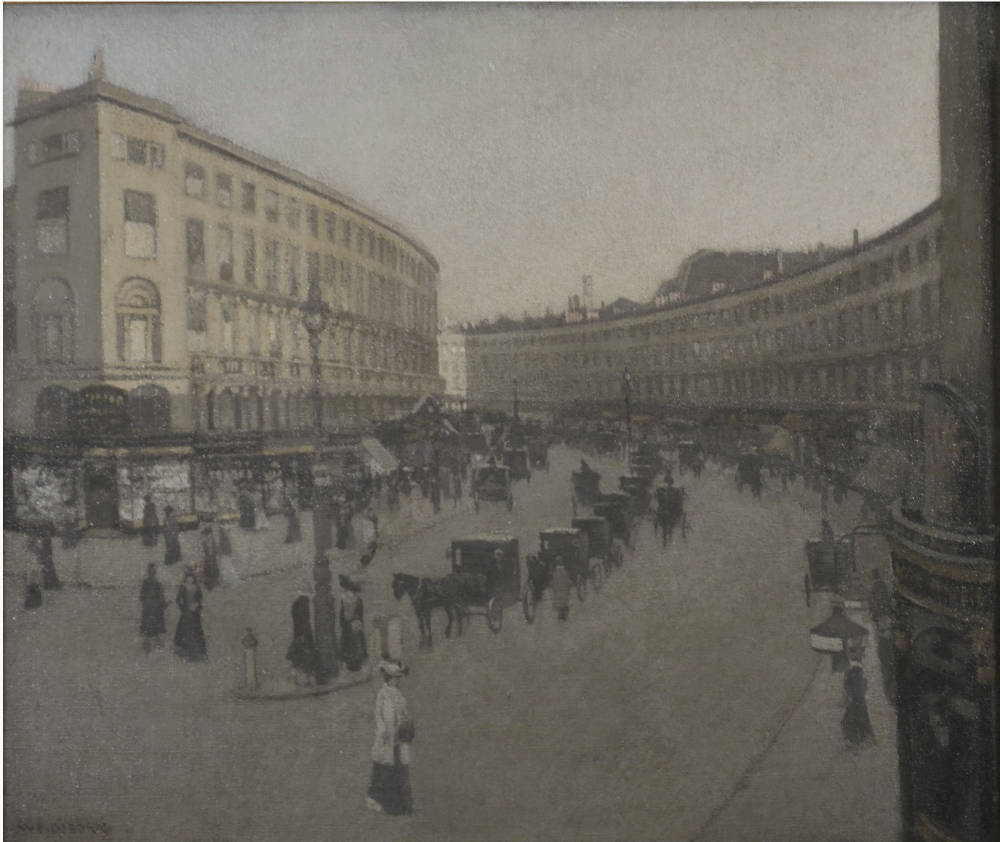
Regent Street, London by William Evelyn Osborn. 1901. Oil on canvas, 51.00 x 61.00cm (20.08 x 24.02 inches) Courtesy of Sarah Colegrave Fine Art. Provenance: Brian Sewell collection. (Detail: Figure in foreground) Click on image to enlarge it.
Commentary by Sarah Colegrave
William Evelyn Osborn was born in St Pancras, London, the eldest son of Edward Osborn, a government factory inspector. Osborn first visited and settled in St Ives in 1891 and was an early member of the St Ives Arts Club. In 1896 he married the St Ives artist Dorothy Worden. In the early 1900s they returned to London, living in Chelsea, where he became a close friend of Paul Maitland and mixed with other Chelsea artists. In Chiaroscuro (1952) Augustus John wrote about meeting Osborn in the a Chelsea restaurant and discusses the artist’s restrained palette:
In the corner by the fireplace, a rather silent and dejected figure use do sit; this was William Osborne [sic]. Henry Lamb, then a young artist lately arrived from Manchester, and I soon got to know him, and the three of us became intimate and spent a good deal of time together. We found a common interest in the subject of painting, for Osborne [sic] too was an artist. Our senior in years, ‘Billy’ seemed vastly our superior in knowledge … A once elegant but now dilapidated row of houses in the King’s Road, with their peeling stucco, reminded Billy of a bevy of elderly ladies vainly trying to camouflage the ravages of time under a reckless application of rouge. This sort of thing was very ‘ninetyish’ of course, but it was new to us. Our friend claimed that this method permitted him to paint in any light; by a learned transposition of colour he could deal with Nature in any mood. This was theory; practically, he preferred the weather to accommodate itself to his palette, as in London it often did. He used few colours and those sparingly. Black was his basic pigment. ‘As for the rose of brick’, he said, ‘a little burnt umber and white suffices”. [pp. 228-29]
In 1906, after suffering for some time with facial neuralgia, he died in Chelsea, perhaps as a result of over-dosing on chloroform which he took to for pain relief. The contents of his studio were left to Paul Maitland.
Osborn’s painting of Royal Avenue, Chelsea is in the collection of the Tate Gallery, London. He was a regular exhibitor at Show Day in St Ives and also exhibited in Liverpool, Manchester, Paris and at the Royal Academy, London. A memorial exhibition was held at W B Paterson, London in 1906.
This painting of Victorian Regent Street is seen from the west side of the street, looking south east, towards Piccadilly Circus. The building on the opposite corner is 104 Regent Street, at the junction with Glasshouse Street.
Sarah Colegrave Fine Art, London has most generously given its permission to use in the Victorian Web information, images, and text from its catalogues. The copyright on text and images from their catalogues remains, of course, with the Gallery. Readers should consult the gallery website to obtain information about recent exhibitions and to order their catalogues. [GPL]
Last modified 11 June 2018